Key Takeaways
- Text-formatted numbers silently sabotage Excel reports, causing SUM formulas to fail, PivotTables to miscount, and charts to display incorrectly
- Manual conversion methods require technical knowledge and multiple steps, creating frustration for business users who just want accurate data
- Excelmatic's AI approach eliminates the complexity - simply describe your conversion needs in plain language and let the AI handle the technical details
- For reliable data cleaning without the Excel expertise, Excelmatic provides the fastest path from messy imported data to analysis-ready numbers
When working in Excel, numbers can sometimes be stored as text. This commonly happens when importing data from web pages, databases, PDFs, or text files. You can recognize this when you see numbers aligning to the left of a cell, formulas not calculating correctly, or small green triangles appearing in the corner of cells.
If left uncorrected, text-stored numbers can lead to issues, such as errors in SUM() formulas, inaccurate PivotTables, and broken charts. These problems can compromise the accuracy of reports and slow down data processing. In this guide, we'll cover several tried-and-true methods to fix this issue and introduce a powerful AI-driven solution that handles it for you.
How to Identify Numbers Stored as Text
Before you can fix the problem, you need to spot it. Here are a few easy ways to confirm if Excel is treating your numbers as text:
- Visual Cues: Numbers stored as text often appear left-aligned in their cells, while true numbers default to right alignment. You may also see a small green triangle error indicator in the cell's corner.
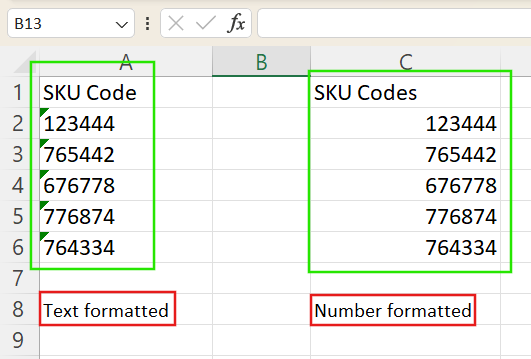
- The
ISNUMBER()Function: You can use this formula to verify. For example, entering=ISNUMBER(A2)will returnTRUEif the value inA2is a number andFALSEif it’s text.
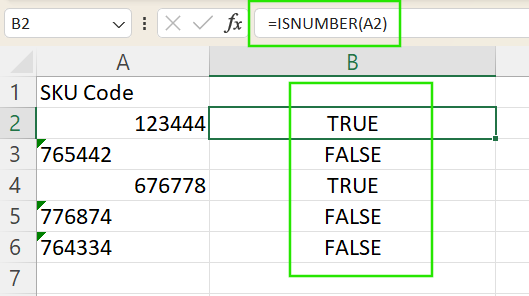
- The Excel Status Bar: The Status Bar provides more clues. When you select a range of true numbers, you’ll usually see
SUM,AVERAGE, andCOUNTdisplayed automatically. If the selection includes numbers stored as text, onlyCOUNTmay appear, which is a sure sign of a data type issue.
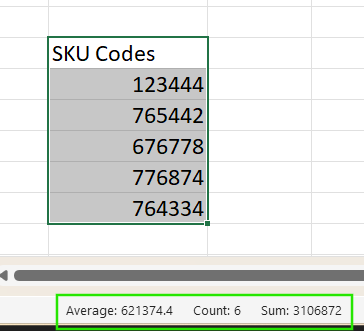
The AI-Powered Method: Using Excelmatic
Before diving into manual fixes, consider the fastest and most intelligent approach: using an AI agent like Excelmatic. Instead of remembering formulas or navigating menus, you can simply tell the AI what you want to do in plain language.

Excelmatic is an AI Excel Agent that analyzes your Excel files and performs tasks based on your instructions. It excels at data cleaning, including the tricky "text-to-number" conversion.
Here’s how it works:
- Upload your file to the Excelmatic platform.
- State your request in simple terms, such as: "In the 'Sales' column, convert all text-formatted numbers into actual numbers."
- Let Excelmatic do the work. The AI not only converts the numbers but also intelligently handles underlying issues like hidden spaces or non-printable characters that often cause manual methods to fail.

AI Agent vs. Traditional Methods: A Quick Comparison
| Feature | Traditional Excel Methods | AI Agent (Excelmatic) |
|---|---|---|
| Effort | High: Requires multiple steps and formula knowledge. | Low: A single plain language instruction. |
| Speed | Slow to Moderate: Depends on user skill and data size. | Fast: Delivers instant, accurate results. |
| Troubleshooting | Manual: You may need to combine TRIM, CLEAN, VALUE. |
Automatic: Intelligently handles hidden issues. |
| Learning Curve | Moderate: Requires remembering specific functions/steps. | None: Intuitive and conversational. |
While manual methods are good to know,*Excelmatic is the modern, efficient solution for busy business professionals who need fast and accurate results without the technical hassle.
Traditional Methods to Convert Text to Numbers in Excel
If you prefer a hands-on approach or want to master Excel's built-in tools, here are the most common techniques. Choosing the right one depends on your specific situation.
1. Use the "Convert to Number" Error Checking Feature
If Excel detects numbers stored as text, a small green triangle appears. This is the quickest manual fix.
- Select the cell or range of cells.
- Click the yellow exclamation point icon that appears.
- Choose Convert to Number from the dropdown menu.

This method is fast but only works when Excel automatically recognizes the error.
2. Change the Cell Format to General or Number
You can try manually changing the cell format.
- Select the cells you want to convert.
- Go to the Home tab.
- In the Number group, open the format dropdown and select General or Number.

Note: If numbers are already entered as text, simply changing the format may not be enough. You might need to re-enter the data in each cell or use one of the following methods to force the conversion.
3. Use Paste Special (Multiply by 1)
This is a reliable trick that forces Excel to re-evaluate the cell content as a number.
- Type
1into any empty cell. - Copy that cell (Ctrl + C).
- Select the range of cells containing numbers formatted as text.
- Right-click → Paste Special.
- In the dialog box, select Multiply under the "Operation" section and click OK.
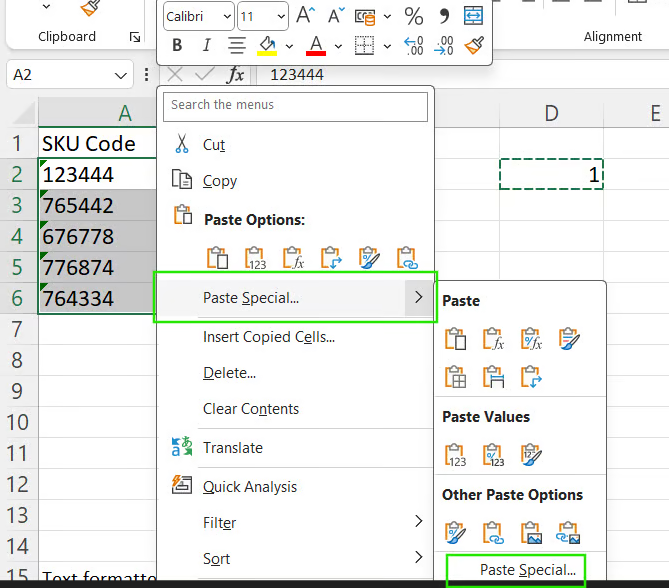
This operation multiplies each value by 1, which doesn't change the number but forces Excel to convert it from text to a numeric type.
4. Perform Simple Arithmetic in a Helper Column
Similar to the last method, you can use a simple formula to trigger the conversion.
- In a new column, enter a formula like
=A2+0or=A2*1(assuming your text-number is in A2). - Press Enter and drag the fill handle down to apply the formula to all relevant cells.
- You can then copy the new column and use Paste Special > Values to replace the original data.
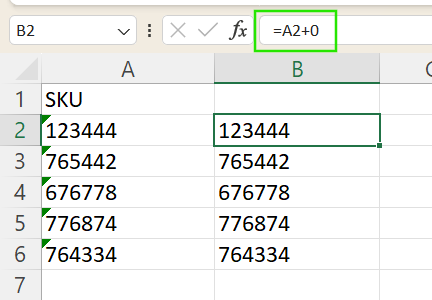
5. Use the Text to Columns Tool
This tool is surprisingly effective for re-formatting data, even if you don't intend to split it.
- Select the column containing the numbers stored as text.
- Go to the Data tab and click Text to Columns.
- In the wizard, choose Delimited and click Next.
- Uncheck all delimiter boxes and click Next.
- Ensure the "Column data format" is set to General. Click Finish.
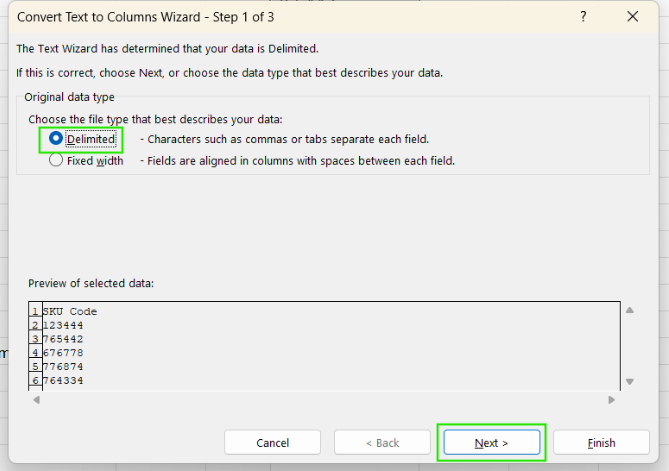
This process forces Excel to re-parse the data in each cell, converting it to the "General" format, which automatically recognizes numbers.
6. Use the `VALUE()` Function
The VALUE() function is designed specifically to convert a text string that represents a number into an actual number.
- In a blank helper column, enter the formula
=VALUE(A2). - Drag the formula down to apply it to the rest of your data.
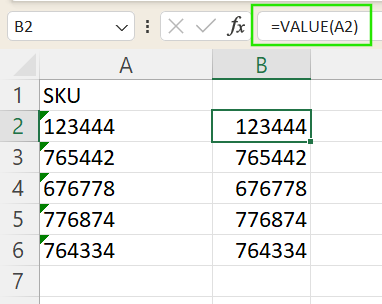
This is a clean and direct formula-based approach, though it requires a temporary extra column.
Troubleshooting Cases Where Manual Methods Fail
Sometimes, standard conversion methods fail. This is usually due to invisible issues in the data, especially when it's imported from external sources. This is where an AI agent shines, as it often detects and resolves these problems automatically. However, if you're fixing it manually, here's what to look for:
- Hidden Spaces: The
TRIM()function removes extra spaces from the beginning or end of a text string. You can combine it withVALUE()like this:=VALUE(TRIM(A2)).

- Non-Printable Characters: Data from web pages or PDFs can contain non-printable characters (like line breaks). The
CLEAN()function removes them. Use it in combination:=VALUE(TRIM(CLEAN(A2))).

- Unusual Symbols: If you suspect other invisible characters, use
=UNICODE(LEFT(A2, 1))to check the character code of the first character in a cell. This can help you identify what's causing the issue.
Key Points to Remember
When dealing with numbers stored as text, you have a choice between manual control and AI-powered efficiency.
- For a quick, no-fuss solution, an Excelmatic is the best choice is the best choice. It saves time and handles complex cleaning tasks automatically.
- For manual fixes, start with the easiest solutions like Error Checking or Paste Special.
- For stubborn cases, especially with imported data, you may need to combine functions like
VALUE(),TRIM(), andCLEAN().
Mastering these techniques will ensure your data is always accurate and your calculations are reliable, but for business users who need immediate results without the technical overhead, Excelmatic provides the most efficient path to clean, analysis-ready data.
Ready to stop struggling with text-formatted numbers? Try Excelmatic today and experience the power of AI-driven data cleaning for yourself.
Excel FAQs
How can I quickly spot numbers stored as text?
Look for left-aligned cells, green error triangles, or use the =ISNUMBER() formula to check if it returns FALSE.
What is the fastest way to convert text to numbers?
The absolute fastest way is to use Excelmatic, which requires just one plain-language command. The fastest manual method is the "Convert to Number" error-checking feature, if it appears.
How does Paste Special multiply by 1 work?
Multiplying by 1 forces Excel to perform a mathematical operation, which re-evaluates the text as a number without changing its value.
When should I use Text to Columns?
Use it when other simple methods fail, especially if you suspect hidden formatting issues. It forces Excel to re-parse the data.
How do I fix numbers from messy PDF or web imports?
These often contain hidden spaces or characters. The most robust manual solution is a combination formula: =VALUE(TRIM(CLEAN(cell))). An AI tool is often more effective as it handles this automatically.
How do I detect invisible characters?
Use =UNICODE(LEFT(A1,1)) to find the character code of the first symbol in a cell, which can help you diagnose the problem.






